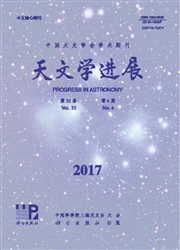

 中文摘要:
中文摘要:
太阳银心距的测定对一些领域的天体物理研究具有不可替代的重要作用。在将近一个世纪的时间内,人们通过各种互相独立的途径,不断提高太阳银心距R0测定(包括绝对测定和相对测定)值的精确度和可靠性。1985年IAU的推荐值为R=(8.5±1.1)kpc;1993年Reid依据之前的多途径测定结果,得出其最优测定值可取为R=(8.0±0.5)kpc,且为嗣后的许多研究工作所采用。该文对有关工作给予简要的介绍和评述,并利用1993年以来R的各类测定结果得到最优估值R=(7.82±0.16)kpc。
 英文摘要:
英文摘要:
Since the seminal work of Shapley (1918) on the distribution of globular star clusters in the Milky Way Galaxy, from which R, the distance from the Sun to the Galactic center, was first estimated, astronomers have paid lots of effects to determine R as accurately as possible by using various methods. The importance of determining Re is that its value has close relationship with studies on astronomy and astrophysics, especially with some topics on Galactic and extragalactic distance scales. Since extragalactic distances are based on Galactic calibrations, the Hubble constant and Re are interrelated. Following what M. J. Reid did, methods used for measuring R can be categorized as primary measurements, secondary measurements and indirect measurements. The primary measurements are defined as a distance measured directly, with no secondary calibration such as "standard candle" calibration or Galactic rotation model, to a tracer at or very near to the Galactic center. It is an approach to absolutely estimate R. On the other side, secondary measurements of R need to use luminosity distances to sources whose distribution can be or are assumed to be symmetrical about the Galactic center. Obviously, this category belongs to relative estimation of R. Finally, indirect measurements combine different kinds of observations with a Galactic model or some other theoretical constrains. Before the end of the 20 century, the only tracers which can be used for absolute determination of R without any calibration are the H2O maser sources very near to the Galactic center, such as ones in Sgr B2. According to the principle of statistical parallax one can obtain a fairly precise estimate of R from proper motions and line-of-sight velocities of maser spots. Early in this century, values of R were determined from measurements of a star orbiting the compact radio source Sgr A* on the basis of the classical "orbiting binary" technique and from the central star cluster based on the statistical parallax method. So far as the
 同期刊论文项目
同期刊论文项目
 同项目期刊论文
同项目期刊论文
 The mass profile of early-type galaxies in overdense environments: the case of the double source-pla
The mass profile of early-type galaxies in overdense environments: the case of the double source-pla Multi-Wavelength Study of a Complete IRAC 3.6micron-Selected Galaxy Sample: a Fair Census of Red and
Multi-Wavelength Study of a Complete IRAC 3.6micron-Selected Galaxy Sample: a Fair Census of Red and New Estimates of the Inclination, Position Angle, Pitch Angle, and Scale Height of the Whirlpool Gal
New Estimates of the Inclination, Position Angle, Pitch Angle, and Scale Height of the Whirlpool Gal Bayesian galaxy shape measurement for weak lensing surveys - III. Application to the Canada-France-H
Bayesian galaxy shape measurement for weak lensing surveys - III. Application to the Canada-France-H JET POWER EXTRACTED FROM ADAF AND THE APPLICATIONS TO X-RAY BINARIES AND THE RADIO GALAXY FR DICHOTO
JET POWER EXTRACTED FROM ADAF AND THE APPLICATIONS TO X-RAY BINARIES AND THE RADIO GALAXY FR DICHOTO 期刊信息
期刊信息
